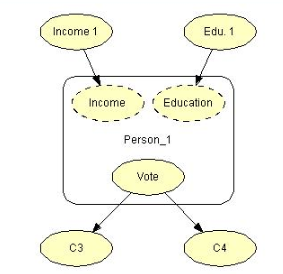Output Node¶
In order for an instance, I, of a network, C, to be applied in another network, N, (via an instance node in N representing I), a mechanism is required for connecting I (or rather nodes of I) to other nodes of N. As we wish to enforce modularity and information hiding, we cannot allow all nodes of I to have children outside I, as that would violate the information hiding constraint. Therefore, we need the concept of output nodes. An output node of I (declared as such in the network class C) is visible outside I, and can thus be used as a parent node of nodes outside I. Note that an output node cannot be a child of nodes outside I, as this would violate the modularity constraint (the domain of a CPT could then contain nodes from several networks).
The network in Figure 1 contains an instance of a network class, Person, describing the relationships between some indicator parameters (say income, education, etc.) and how these affect the probability distribution over political sympathy, say Republican or Democrat, for a person. Given the bindings of the indicator variables Income and Education (see the description of input nodes for details) to “Income 1” and “Edu. 1”, we are interested in the resulting probability distribution for Person_1’s political sympathy. Therefore, the variable Vote must be visible outside instances of the network class Person. Thus, the variable Vote is made an output node of Person.

Figure 1: The variables “Income 1” and “Edu. 1” are bound to input variables Income and Education of the instance node Person_1.¶
In our network, we have used the output variable Vote as a parent variable of the nodes C1 and C2.
In the tutorial on object-oriented networks, an example shows how to use input and output nodes.
See also the description of input nodes. Input nodes and output nodes are collectively referred to as interface nodes.
